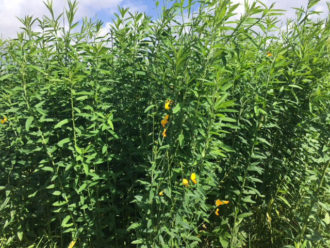While the benefits of cover crops are similar regardless of cash crop, there are a number of benefits that are particularly important to vegetable producers. The main benefits of cover crops in vegetable production include increased organic matter; additional N through the use of legumes; suppressing disease, nematodes, and weeds; reducing soil erosion; providing habitat for beneficial insects; and improving soil tilth.
Strawberry (Fragaria L.) producers in Alabama have recognized the economic benefit of integrating cover crops into their production system to reduce commercial nitrogen use thus reducing production costs. Certain cover crops are more efficient at mining residual nutrients, such as phosphorus (P) and potassium (K). As the cover crop breaks down, these nutrients become available to the cash crop.
Advantages and Disadvantages of No-till Vegetable Production
When considering a no-till vegetable production system with cover crops, producers should consider the advantages and disadvantages associated with the practice when compared to plasticulture. While many of the benefits are agronomic in nature, they may also provide economic benefits.
One of the main benefits of moving to no-till vegetable production is a reduction in equipment and labor needs compared to plasticulture. While both plasticulture and no-till production require the use of a sprayer and planter or transplanter, producers using plastic require more equipment prior to planting including: at least one pass with a turning plow or chisel plow; at least one pass with a disc or tiller; and one or two passes with a bed shaper and plastic layer depending on the type of equipment. Assuming the use of a cover crop, no-till production requires a pass to terminate the cover crop using a roller/crimper, flail mower, bush hog, tiller, or other equipment.
Additionally, one of the major advantages of a no-till system is not using plastic in production. There are significant labor costs associated with installing plastic and removing it from the field. There are disposal costs after harvest and torn pieces do not rapidly degrade. Furthermore, it is not financially feasible to grow some crops on newly laid plastic.
There is less soil erosion under a no-till system and yields can be similar or the same as under plastic. Vegetables grown in a no-till system tend to be cleaner at harvest than vegetables grown on bare ground. Fertilizer needs can be reduced with an appropriate cover crop, such as a legume, which is a direct economic benefit of a no-till production system utilizing a cover crop.
While there are a number of advantages, there are potential disadvantages of adopting a no-till vegetable production system with a cover crop. It takes time to learn how to properly manage the system. Timing becomes more important since producers must take into account the lower soil temperatures in a no-till system as compared to plastic and the timing of terminating cover crops (at least three weeks prior to planting). Weeds can quickly become a problem in a no-till vegetable system, especially for organic producers. Cover crops, along with an in-row compost strip, help to control weeds in no-till systems. Certain crops, such as tomatoes (Solanum lycopersicum), cucurbits, cole crops (Brassica oleracea), southern peas (Vigna unguiculata), and corn (Zea mays), are better suited for a conservation system (Hoyt et al., 1994).
Producers in Alabama have adopted cover crops as part of their plasticulture and no-till vegetable production systems due to the agronomic and economic benefits. The machinery and labor savings, as well as fertilizer savings, has increased the interest in no-till vegetable production with a cover crop.
This product was developed with support from the Southern Sustainable Agriculture Research and Education (Southern SARE) program, which is funded by the U.S. Department of Agriculture—National Institute of Food and Agriculture (USDA-NIFA). Any opinions, findings, conclusions or recommendations expressed within do not necessarily reflect the view of the Southern SARE program or the U.S. Department of Agriculture. USDA is an equal opportunity provider and employer.
